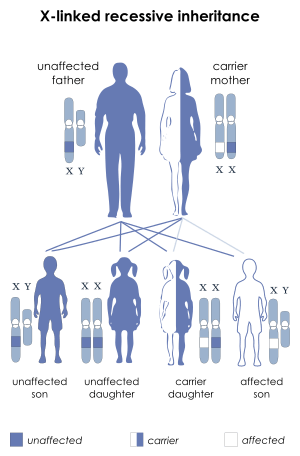Hoyeraal-Hreidarsson syndrome
Hoyeraal-Hreidarsson syndrome (HHS) is a very rare multisystem X-linked recessive disorder characterized by excessively short telomeres and is considered a severe form of dyskeratosis congenita.[2][3] Being an X-linked disorder, HHS primarily affects males. Patients with HHS typically present in early childhood with cerebellar hypoplasia, immunodeficiency, progressive bone marrow failure, and intrauterine growth restriction.[2] The primary cause of death in HHS is bone marrow failure, but mortality from cancer and pulmonary fibrosis is also significant.[4][5][6]
| Hoyeraal-Hreidarsson syndrome | |
|---|---|
| Other names | Progressive pancytopenia-immunodeficiency-cerebellar hypoplasia syndrome [1] |
 | |
| This condition is inherited in an X-linked recessive manner | |
| Specialty | Medical genetics |
Presentation
The currently recognized features of HHS are cerebellar hypoplasia, immunodeficiency, progressive bone marrow failure, and intrauterine growth restriction. HHS patients also commonly exhibit symptoms such as microcephaly, aplastic anemia, and intellectual disability.[3]
Overlap with dyskeratosis congenita
In addition to HHS-specific sequelae, HHS patients frequently present with the mucocutaneous triad of nail dysplasia, lacy skin pigmentation, and oral leukoplakia
Pathogenesis
Although the pathogenesis of HHS remains unknown, it is strongly suspected that the clinical sequelae of HHS arise from the accelerated telomere shortening present in HHS patients.[2]
It has been associated with mutations in the poly(A)-specific ribonuclease PARN gene.[7]
Diagnosis
- Neuroimaging - Cerebellar hypoplasia/atrophy, small brainstem, thin corpus callosum and cerebral calcifications.
- Molecular genetic testing - for confirmation.
Treatment
Current treatment is supportive.
- The aplastic anemia and immunodeficiency can be treated by bone marrow transplantation.
- Supportive treatment for gastrointestinal complications and infections.
- Genetic counselling.
TeloCure Ltd. TeloCure Ltd. is developing gene therapy solutions for HHS. The company is funded by the foundation for Noga Baumatz and other HHS patients which was founded by the family of a deceased HHS patient.
See also
References
- RESERVED, INSERM US14-- ALL RIGHTS. "Orphanet: Hoyeraal Hreidarsson syndrome". www.orpha.net. Retrieved 15 June 2019.
- Glousker G, Touzot F, Revy P, Tzfati Y, Savage SA (2015). "Unraveling the pathogenesis of Hoyeraal-Hreidarsson syndrome, a complex telomere biology disorder". Br. J. Haematol. 170 (4): 457–71. doi:10.1111/bjh.13442. PMC 4526362. PMID 25940403.
- Knight SW, Heiss NS, Vulliamy TJ, Aalfs CM, McMahon C, Richmond P, Jones A, Hennekam RC, Poustka A, Mason PJ, Dokal I (1999). "Unexplained aplastic anaemia, immunodeficiency, and cerebellar hypoplasia (Hoyeraal-Hreidarsson syndrome) due to mutations in the dyskeratosis congenita gene, DKC1". Br. J. Haematol. 107 (2): 335–9. doi:10.1046/j.1365-2141.1999.01690.x. PMID 10583221.
- Deng Z, Glousker G, Molczan A, Fox AJ, Lamm N, Dheekollu J, Weizman OE, Schertzer M, Wang Z, Vladimirova O, Schug J, Aker M, Londoño-Vallejo A, Kaestner KH, Lieberman PM, Tzfati Y (2013). "Inherited mutations in the helicase RTEL1 cause telomere dysfunction and Hoyeraal-Hreidarsson syndrome". Proc. Natl. Acad. Sci. U.S.A. 110 (36): E3408–16. Bibcode:2013PNAS..110E3408D. doi:10.1073/pnas.1300600110. PMC 3767560. PMID 23959892.
- Le Guen T, Jullien L, Touzot F, Schertzer M, Gaillard L, Perderiset M, Carpentier W, Nitschke P, Picard C, Couillault G, Soulier J, Fischer A, Callebaut I, Jabado N, Londono-Vallejo A, de Villartay JP, Revy P (2013). "Human RTEL1 deficiency causes Hoyeraal-Hreidarsson syndrome with short telomeres and genome instability". Hum Mol Genet. 22 (16): 3239–49. doi:10.1093/hmg/ddt178. PMID 23591994.
- Jullien L, Kannengiesser C, Kermasson L, Cormier-Daire V, Leblanc T, Soulier J, Londono-Vallejo A, de Villartay JP, Callebaut I, Revy P, Mutations of the RTEL1 Helicase in a Hoyeraal-Hreidarsson Syndrome Patient Highlight the Importance of the ARCH Domain, Hum Mutat. 2016 May;37(5):469-72.doi: 10.1002/humu.22966.
- Benyelles M, Episkopou H, O'Donohue MF, Kermasson L, Frange P, Poulain F, Burcu Belen F, Polat M, Bole-Feysot C, Langa-Vives F, Gleizes PE, de Villartay JP, Callebaut I, Decottignies A, Revy P (2019) Impaired telomere integrity and rRNA biogenesis in PARN-deficient patients and knock-out models. EMBO Mol Med 11(7):e10201
External links
| Classification |
|---|